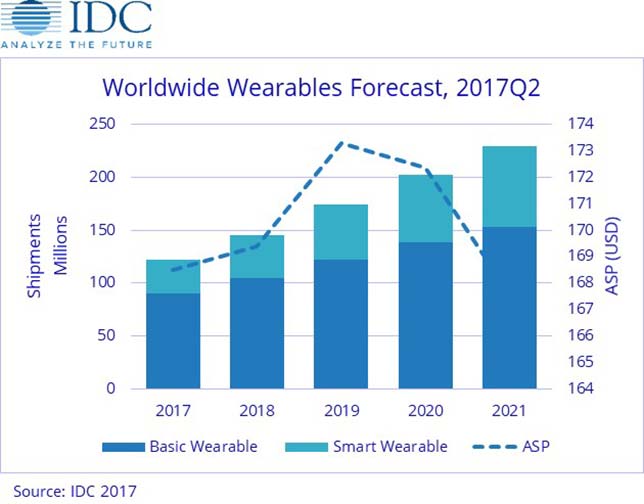Wearables to See Double-Digit Growth through 2021

Sales of wearable devices will post double-digit gains each year through 2021, according to a new forecast from International Data Corp. (IDC).
Vendors will sell 121.7 million devices this year, according to the forecast, up 16.6 percent over last year's 104.4 million shipments. By 2021, the company predicts total sales to reach 229.5 million units on the strength of a compound annual growth rate (CAGR) of 17.2 percent.
Wrist-worn devices will drive the market, according to the company, while "lesser-known wearable products, such as clothing and ear-wear, will experience market-beating growth in the years to come."
"We expect the most innovation and development in the wearables market to take place on the wrist," said Ramon T. Llamas, research manager for IDC's wearables team, in a prepared statement. "It's the ideal location for users to collect, view and interact with data and applications, and the point to execute tasks like responding to notifications or communicating with other people and devices. Layer on top of that varieties in style, design, segment and feature set, and wrist-worn wearables are poised to remain well out in front of the market."
Watches will lead the market this year, according to the forecast, with 67.4 million shipments and a 55.4-percent share. The forecast calls for 154.4 million shipments and a 67.3 percent market share in 2021, a CAGR of 23 percent throughout the forecast period.
"Apple and Android Wear will drive the market forward, but the market will also see new entrants running on their own proprietary operating systems (i.e., Fitbit's own Java-based operating system and Garmin's Connect IQ)," according to a news release. "Meanwhile, basic watches will see their volumes swell past smartwatch volumes by adding wearable technology to traditional watches. Altogether, the diversity of watches and experiences will appeal to a similarly diverse audience with differing tastes and preferences, leading to a larger total available market and growing volumes each year."
Wristbands, currently in second place with 47.6 million sales and a 39.1-percent market share projected for the year, will see more modest growth, riding a CAGR of 1.9 percent to reach 51.3 million shipments and 22.4 percent of the market in 2021.
IDC predicts ear-wear to see the fastest growth at a CAGR of 54.4 percent throughout the forecast period, taking the device category from 1.8 million shipments and a market share of just 1.5 percent this year to 10.5 million shipments and 4.6 percent of the market in 2021.
"Ear-wear presents a different value proposition compared to other devices in that users consume the data over audio," according to a news release. "While conventional music playback seems to be the common thread across all ear-wear, users can also look forward to fitness tracking and coaching, real-time language translation and audio modulation."
Clothing will also see fast growth — 42.8-percent CAGR — while maintaining single-digit market share. Shipping 2.8 million devices for 2.3 percent of the market this year, IDC calls for smart clothing to finish the forecast period selling 11.6 million units for 5.1 percent of the market.
"Clothing will trail far behind wrist-worn wearables, capturing single digit market share but outperforming the overall market in terms of growth," according to information released by the company. "Fitness-oriented clothing for professional and semi-professional teams and athletes, with features that track fitness performance and fatigue embedded within the clothing, will drive volumes forward. Consumer interest will trail further behind as most of these features replicate experiences found on other wearable devices."
"Other factors fueling growth in the wearables market will be the inclusion of cellular connectivity along with improved sensors and algorithms," said Jitesh Ubrani senior research analyst for IDC mobile device trackers, in a prepared statement. "Not only do these technologies provide increased accuracy, but they also make it possible for companies to sell wearables through new channels and more importantly, to new customers."
About the Author
Joshua Bolkan is contributing editor for Campus Technology, THE Journal and STEAM Universe. He can be reached at [email protected].